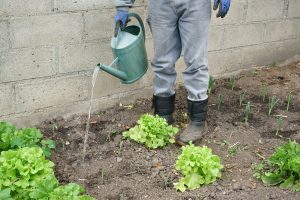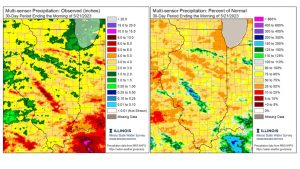Parts of state facing increased risk of drought conditions
Illinois State Climatologist — May 26, 2023
The combination of dryness and above average temperatures in May increased evaporation and plant water use, which depleted soil moisture.
Parts of northeast, western, and central Illinois have been much drier than normal in the past four to six weeks, causing dry soils and lower streamflow.
Perennials, gardens, and young trees in these areas have begun to show some response to the dryness, requiring more frequent watering than typical for late May.
Forecasts for the next week or two show very dry weather and above normal temperatures, which will likely worsen already dry conditions in the state and potentially induce rapid onset drought conditions in some areas.
As conditions evolve, accurate reports on conditions and drought impacts are critical to accurately assess what parts of the state are in drought and what parts are not. Whether your area is currently wet, close to normal, or dry, please consider reporting conditions and any drought impacts you see or hear via the National Drought Mitigation Center’s Condition Monitoring Observer Report (CMOR, https://droughtimpacts.unl.edu/Tools/ConditionMonitoringObservations.aspx) system or by email to the State Climatologist Office (statecli@isws.illinois.edu).
A dry pattern has been in place over Illinois since mid-April. Outside of a few areas of heavy rain, most places have had between 60 percent and 90 percent of normal precipitation in the last 30 days.
Parts of central and western Illinois, the St. Louis Metro East, and virtually all of the Chicago area have had less than 50 percent of normal rainfall since April. As of May 22, Chicago has had only 0.42 inches of total May precipitation, more than 2 inches below normal by this time in May.

Maps show (left) total precipitation and (right) precipitation percent of normal over the last 30 days. (Photo courtesy of Illinois State Climatologist)
The combination of dryness and above average temperatures in May increased evaporation and plant water use, which depleted soil moisture.
The lack of consistent rain and dry soils have acted together to reduce levels in some streams and rivers across northeast, central, and western Illinois.
Several streams in northeast and east-central Illinois have seen flow dip well below normal this month, including the Vermilion River at Pontiac and Lenore, the Illinois River at Marseilles and Henry, and the Sangamon River at Fisher and Monticello.
While the recent dryness is beginning to affect stream levels in Illinois, drought has not persisted enough to significantly affect water resources. Drought in Illinois typically impacts plants and crops first, as soil moisture is depleted; but can begin to impact water resources and water quality if it persists.







